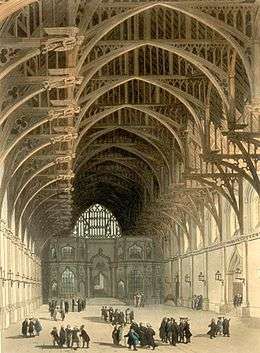Almshouse



Almshouses are charitable housing provided to enable people (typically elderly people who can no longer work to earn enough to pay rent) to live in a particular community. They are often targeted at the poor of a locality, at those from certain forms of previous employment, or their widows, and are generally maintained by a charity or the trustees of a bequest.[1]
European
Many almshouses are European Christian institutions though some are secular.[2] Alms are, in the Christian tradition, money or services donated to support the poor and indigent. Almshouses were established from the 10th century in Britain, to provide a place of residence for poor, old and distressed people. The first recorded almshouse was founded in York by King Athelstan; the oldest still in existence is the Hospital of St. Cross in Winchester, dating to about 1132. In the Middle Ages, the majority of European hospitals functioned as almshouses.
In 1269 or 1270 an almshouse was established in Stavanger as the first known in Norway.[3]
United States
The English tradition of almshouses was introduced to the Commonwealth of Pennsylvania by its founder, William Penn. The Maryland legislature created almshouses in Anne Arundel County, financed by property taxes on landowners throughout the state. Massachusetts also had a long tradition of almshouses.
In the United States, aid tended to be limited to the elderly and disabled, and children had to sleep in the same rooms as adults.[4]
Continuity
Almshouses have been created throughout the period since the 10th century, up to the present day. Many of the medieval almshouses in England were established with the aim of benefiting the soul of the founder or their family, and they usually incorporated a chapel. As a result, most were regarded as chantries and were dissolved during the Reformation, under an act of 1547. To many, religion is less important now than it was in Medieval times, and the Christian side of almshouses no longer applies to all voluntary sector housing, though some maintain a Christian tradition. Almshouses tend to be characterised by their charitable status and by the aim of supporting the continued independence of their residents.
There is an important delineation between almshouses and other forms of sheltered housing in that almshouse residents have no security of tenure, being solely dependent upon the goodwill of the administering trustees.
Physical form
In physical form, and owing in part to the antiquity of their formation, almshouses are often very dated buildings comprising multiple small terraced houses or apartments, and providing accommodation for small numbers of residents; some 2,600 almshouses continue to be operated in the UK, providing 30,000 dwellings for 36,000 people. In the Netherlands, a number of hofjes are still functioning as accommodation for elderly people (mostly women). The economics of almshouses takes the form of the provision of subsidised accommodation, often integrated with social care resources such as wardens. The basis for modern civil almshouses and workhouses came into being in 1597 when the Act for the Relief of the Poor was enacted. These institutions underwent various population, program, and name changes, but by 1900 the elderly made up 85 percent of the population in these institutions (Day 2009).
-
%2C_Church_Lane%2C_Godstone.jpg)
St Mary's Almshouses (North Wing), Church Lane, Godstone
-

The Dutch almshouse in Boshuisen
-

The Dutch almshouse in Leeuwarden
-

Almshouse cottages in Whiteley Villages
-

The Dutch almshouse in Gouda
-

Queens' College, Cambridge almshouses in 1912
-

-
Royal Albert Homes, Cambridge
See also
- Blockley Almshouse
- Carroll County Almshouse and Farm, Westminster, Maryland
- Halfway house
- Hostel
- List of British almshouses
- Poorhouse
References
- ↑ Just the Facts 101 Public Health Nursing, Population-Centered Health Care in the Community. Content Technologies. 2013. ISBN 9781478428220.
- ↑ "Photography » Ancestral Deeds - Research & Transcription Services". www.ancestraldeeds.co.uk. Retrieved 15 September 2016.
- ↑ "Diplomatarium Norvegicum Volum 10 No.4". www.dokpro.uio.no. Retrieved 15 September 2016.
- ↑ "Asian Caregivers & Elderly Care". Myasiannanny.com. Retrieved 15 September 2016.
Further reading
- Heath, Sidney (1910). Old English houses of alms: a pictorial record with architectural and historical notes. London: F. Griffiths.
- Rothman, David J., ed. (1971). The Almshouse Experience. Poverty USA: The Historical Record. Arno Press. ISBN 0-405-03092-4.
- Caffrey, Helen (2006). Almshouses in the West Riding of Yorkshire 1600-1900. Kings Lynn: Heritage. ISBN 1-905223-21-8.
- Goose, Nigel; Caffrey, Helen; Langley, Anne, eds. (2016). The British Almshouse: new perspectives on philanthropy ca 1400-1914. Milton Keynes: FACHRS. ISBN 978-0-954-81802-9.
External links
| Wikimedia Commons has media related to Almshouses. |
- The Almshouse Association
- The Almshouse Residents Action Group
- List of English Almshouses associated with monastic institutions. (From public domain text, English Monastic Life)
- Medieval Hospitals (Almshouses) of England, by Rotha Mary Clay. (Public domain text, including daily life, care, and the "Office at the Seclusion of a Leper".)
- What Are Almshouses
